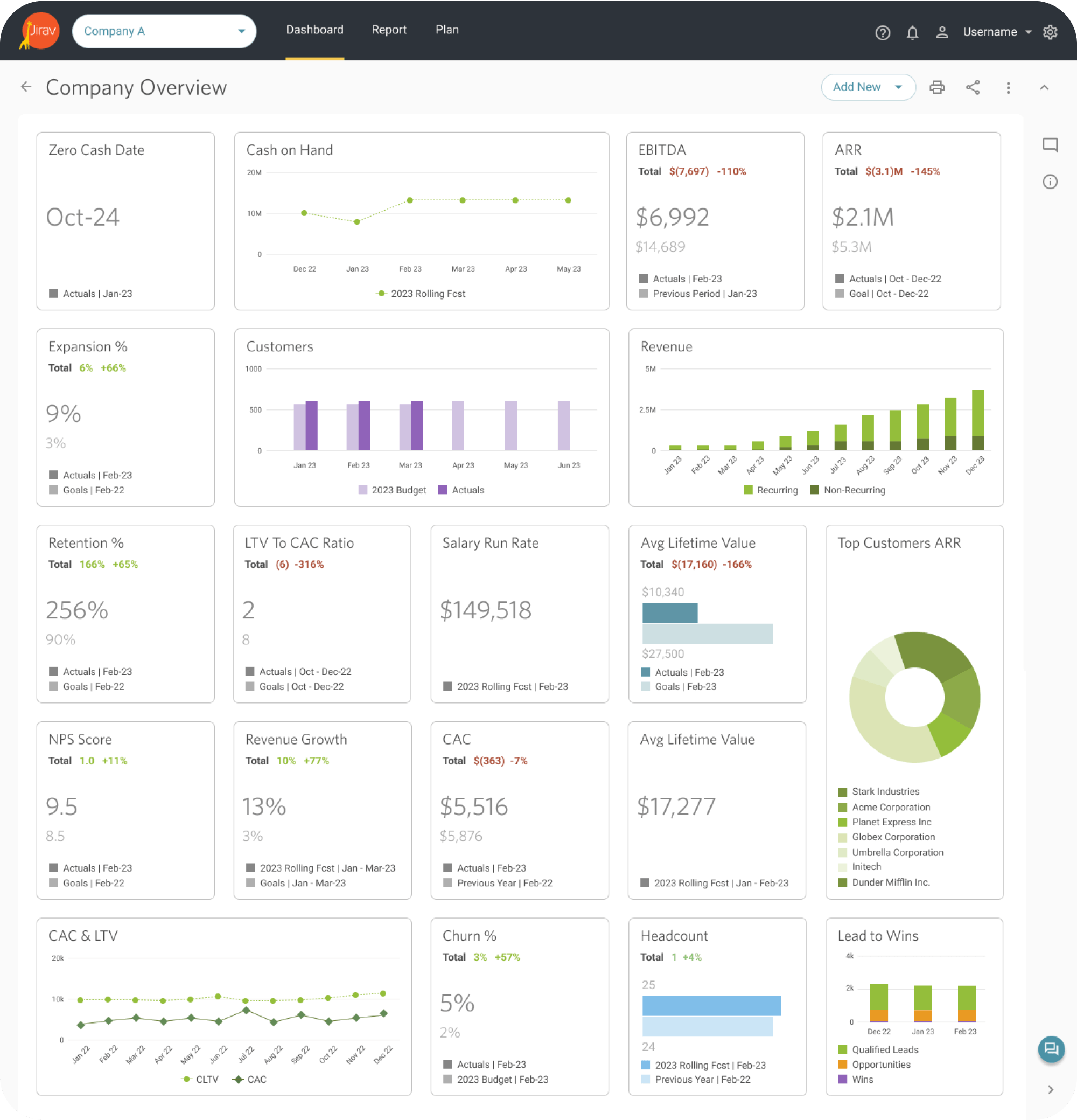Every business owner knows that managing finances is critical to running a successful enterprise. As such, it's important to have a clear understanding of how much money is coming in and going out at any given time.
With a clearer look at the cash moving in and out of their accounts, businesses and finance managers can make informed decisions about how to allocate resources, manage debt, and plan for the future.
In this guide, we’ll explore what it takes to conduct a cash flow analysis and provide some tips for interpreting the results to optimize financial management.
What is a cash flow statement?
A cash flow statement is a financial report that outlines the inflow and outflow of cash in a business over a specific period. It’s an essential tool for assessing a company's liquidity, solvency, and overall financial health.
The purpose of the cash flow statement is to provide a detailed breakdown of the cash transactions of a business. It records all cash inflows and outflows from different activities, like operations, investments, and financing. By analyzing the cash flow statement, investors and financial analysts can gain insights into how a company generates and uses its cash.
The cash flow statement typically comprises three sections: cash flow from operating activities, cash flow from investing activities, and cash flow from financing activities.
Cash flow from operating activities
This section shows the cash generated from a company's primary business operations, like sales and services, cash received from customers, cash paid to suppliers, and cash paid to employees. It also includes any interest and income tax payments made by the company.
The operating activities section of a cash flow statement is crucial in determining how much cash is generated or spent in a company's day-to-day operations. This amount reflects the revenue that the company earned during the period and can provide insight into the overall financial health of the company.
Cash flow from investing
This records cash flows related to the purchase or sale of long-term assets, like property, plant, and equipment. It also includes investments in other companies or securities, as well as any proceeds from the sale of such investments.
Investors often monitor a company's capital expenditures to manage finances or to add new physical assets, which in turn supports the company's competitiveness and operations. Tracking cash inflows and outflows from capital expenditures and long-term investments can provide valuable insights into a company's financial health.

Cash flow from financing
This section shows the cash inflows and outflows related to the company's financing activities, like issuing stock or taking out loans. It reports any cash inflows or outflows that result from borrowing or repaying debt, as well as any cash inflows or outflows related to equity transactions like issuing or repurchasing stocks or bonds.
Since cash, not net income, is used to pay dividends to shareholders, analyzing the cash flows from financing activities can provide investors with valuable insights into a company's dividend payment policy and its ability to sustain its dividend payments over time.
In addition to dividends, the financing activities section also includes any cash received from taking out loans, as well as any cash used to pay down long-term debt. These figures can be used to assess a company's borrowing and repayment activity and its overall debt management strategy.
It's important to note that the cash flow statement is different from the income statement and balance sheet. While the income statement shows a company's revenue and expenses during a specific period, the cash flow statement focuses on cash transactions. The balance sheet, on the other hand, shows a company's assets, liabilities, and equity at a particular point in time.
What is a cash flow analysis?
In simple terms, cash flow analysis involves examining the inflows and outflows of cash over a specified period to gain insights into a company's liquidity, solvency, and overall financial performance.
While the cash flow statement breaks down cash inflows and outflows for a specific period, a cash flow analysis involves reviewing the cash flow statement and determining whether there is a net positive or negative cash flow.
Analyzing the cash flow statement can also help identify trends, like whether a company is generating positive cash flow from operating activities, or if it’s relying heavily on financing activities to generate cash.
With cash flow analysis, businesses and investors can identify potential problems with cash flow, like negative cash flow, and develop strategies to address them. In this regard, cash flow forecasting helps businesses predict future cash flows based on past cash flow patterns and future expectations. This way, businesses can plan for future cash needs and manage their cash reserves effectively.
One way to conduct a basic cash flow analysis is to examine the cash flow statement, comparing the outflows with the inflows and drawing subsequent conclusions.
While cash flow analysis can include several ratios, the following indicators provide a starting point for investors to measure the investment quality of a company's cash flow:
- Operating Cash Flow: This measures a company's ability to generate cash from its core operations. It's calculated by subtracting operating expenses from operating revenues.
- Free Cash Flow: This measures the amount of cash a company generates after accounting for capital expenditures. It's calculated by subtracting capital expenditures from Operating Cash Flow.
- Levered Free Cash Flow: This measures the amount of cash a company generates after accounting for all financial obligations. It's calculated by subtracting interest payments and debt repayments from Free Cash Flow.
Cash flow analysis helps investors better understand if a business's financial health is from sales, debt, or other financing and project strategies that improve its cash flow.
Why is a cash flow analysis important?
Managing business finances can be challenging, and understanding the inflows and outflows of cash is essential for making informed decisions about investments, expenses, and overall financial health. Here's why cash flow analysis is crucial to business success:
It helps identify potential financial problems
One of the main benefits of conducting a cash flow analysis is that it helps businesses identify potential financial problems before they become too big to handle. By analyzing the inflow and outflow of cash, a company can identify areas where it may be overspending or where it may have insufficient cash reserves to cover upcoming expenses. For example, a company that has more cash going out than coming in may be at risk of running out of funds to pay its bills.
It providing insights into financial trends
Another benefit of cash flow analysis is that it provides valuable insights into financial trends. By examining cash flow patterns over time, a business can identify trends in its revenue and expenses. This information can be used for financial forecasting, identifying areas where expenses can be reduced, and determining the best strategies for growth.
It’s measurable and comparable
Cash is a tangible asset that can be measured and compared across different companies. By analyzing a company's cash inflows and outflows, companies can get a clear picture of their financial health and compare it to similar businesses. This information can be useful for investors, lenders, and other stakeholders who need to make informed decisions about where to invest their money.
It’s hard to misrepresent
Unlike other financial statements that can be manipulated or misrepresented, cash flow analysis is more difficult to falsify. Cash is a real asset that can be counted and verified, making it an essential tool for detecting financial fraud and other irregularities. This makes cash flow analysis a reliable indicator of a company's financial health.
It’s universally accepted
Cash is universally accepted as a store of value. Whether you're dealing with customers, suppliers, or other stakeholders, cash is the most widely accepted form of payment. This means that cash equals value, and a company's cash flow is a good indicator of its overall financial strength.

It assists in business planning and budgeting
Cash flow analysis is also important for budgeting and financial planning. By analyzing cash flow, a company can create realistic budgets that reflect its current financial situation. This information can be used to make informed decisions about capital expenditures, staffing levels, and other investments.
Cash Inflow vs Cash Outflow
Cash inflow and cash outflow are two crucial concepts in the world of finance. They represent the movement of money in and out of a business or individual's account. Understanding the relationship between these two terms is essential for effectively managing finances.
Cash Inflow
Cash inflow refers to the amount of money that a business or individual receives or earns during a specific period. It includes all income earned, like revenue from sales, interest income, dividends, and loans received. Cash inflow is a positive number, because it represents an increase in the amount of cash available.
A positive cash inflow is critical to the success of any business, as it ensures that the business has the necessary funds to pay its bills, invest in growth opportunities, and reward shareholders. Some examples of cash inflows include:
- Revenue from sales of goods or services
- Interest or dividend income
- Proceeds from the sale of assets, like property or equipment
- Loans or investments from lenders or investors
Cash Outflow
Cash outflow, on the other hand, refers to the amount of money that a business or individual spends or pays out during a specific period. For example, if a business has to pay $1,000 for rent, $500 for salaries, $200 for utilities, and $300 for taxes in a month, the total cash outflow for that month would be $2,000. This means that the business has spent $2,000 during that month, and its cash balance has decreased by that amount.
A cash outflow is a negative number, because it represents a reduction in the amount of cash available. A negative cash outflow can be a sign of financial trouble for a business, as it means that the business is spending more money than it’s earning. Examples of cash outflows include the following:
- Operating expenses like rent, utilities, and payroll
- Payments for goods and services purchased from suppliers
- Interest payments on loans
- Taxes and other regulatory fees
Monitoring cash outflow is crucial for businesses to maintain their financial health. By tracking their expenses, businesses can identify areas where they can reduce costs and optimize their spending, which ultimately improves their cash flow. This can be done by reviewing their accounts payable and identifying ways to negotiate better payment terms with their vendors or suppliers, reducing unnecessary overhead costs like rent or utility bills, and optimizing their inventory management to reduce waste and storage costs.
Monitoring cash inflow is equally important, as it helps businesses and individuals identify opportunities to increase revenue and improve profitability. By analyzing sales patterns to determine which products or services are driving revenue growth, businesses can identify new markets or customer segments to target and implement marketing strategies to attract new customers or retain existing ones.
How FP&A can help with cash flow analysis
Without adequate cash on hand, a company may struggle to pay bills, purchase inventory, or invest in new opportunities. That's where Financial Planning and Analysis (FP&A) comes in.
FP&A is a type of strategic finance that helps companies plan, budget, and forecast their financial performance. By analyzing a company's cash inflows and outflows, FP&A professionals can identify potential cash shortfalls and recommend strategies to optimize cash flow.
FP&A can help with cash flow analysis in the following ways:
Forecasting
One of the primary ways that FP&A can help with cash flow analysis is by providing accurate forecasting. FP&A teams use data analysis and financial modeling tools to forecast a company's future cash inflows and outflows. This helps business leaders plan for potential cash shortfalls and take corrective action before they become a problem.
Budgeting
FP&A teams can also help with cash flow analysis by developing budgets that align with a company's cash flow goals. Setting realistic cash flow targets and developing a budget that supports those targets can help businesses ensure that they have adequate cash on-hand to meet their financial obligations.
Scenario Analysis
This involves modeling different scenarios to see how changes in key financial metrics (like revenue, expenses, and working capital) would impact a company's cash flow. By identifying potential cash flow risks and developing contingency plans, business leaders can prepare for unexpected financial challenges.
Cash Flow Reporting
FP&A teams can help with cash flow analysis by providing regular cash flow reporting. This involves creating financial reports that provide a detailed breakdown of a company's cash inflows and outflows. By reviewing these reports on a regular basis, business leaders can identify trends, make informed financial decisions, and adjust their strategies as needed.
Through accurate forecasting, developing realistic budgets, conducting scenario analysis, and providing regular cash flow reporting, FP&A teams can help business leaders make informed financial decisions and ensure the long-term financial health of their companies.
As outlined in this article, a lot goes into conducting a cash flow analysis; but, tools like Jirav help streamline the process and make it easier to manage business finances.
Book a demo today, and never worry about breaking your model again.












